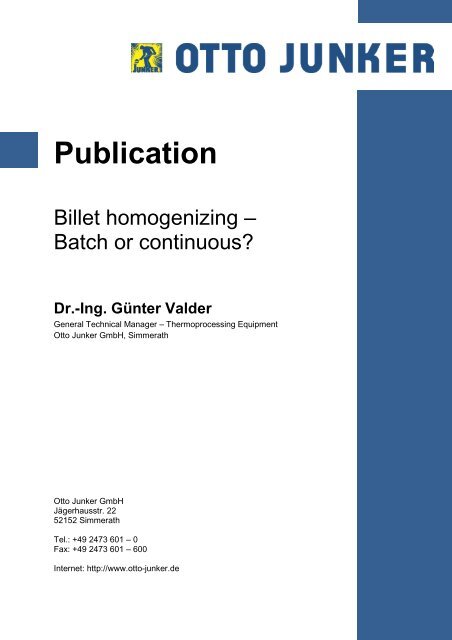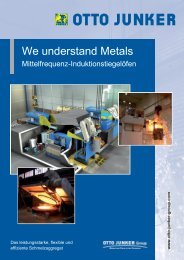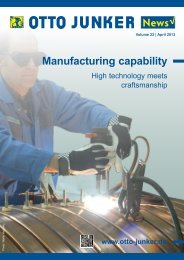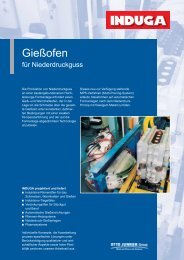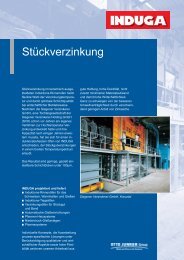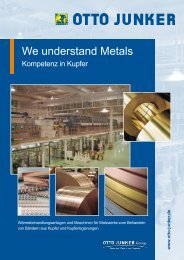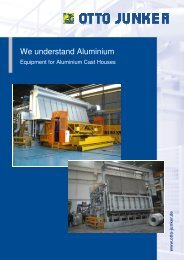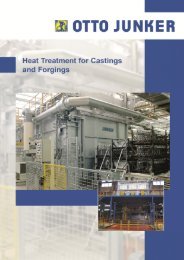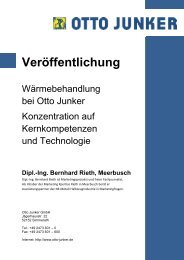Billet homogenising _batch or continuous - Otto Junker GmbH
Billet homogenising _batch or continuous - Otto Junker GmbH
Billet homogenising _batch or continuous - Otto Junker GmbH
Create successful ePaper yourself
Turn your PDF publications into a flip-book with our unique Google optimized e-Paper software.
Publication<br />
<strong>Billet</strong> homogenizing –<br />
Batch <strong>or</strong> <strong>continuous</strong>?<br />
Dr.-Ing. Günter Valder<br />
General Technical Manager – Thermoprocessing Equipment<br />
<strong>Otto</strong> <strong>Junker</strong> <strong>GmbH</strong>, Simmerath<br />
<strong>Otto</strong> <strong>Junker</strong> <strong>GmbH</strong><br />
Jägerhausstr. 22<br />
52152 Simmerath<br />
Tel.: +49 2473 601 – 0<br />
Fax: +49 2473 601 – 600<br />
Internet: http://www.otto-junker.de
2 / 11<br />
<strong>Billet</strong> homogenizing – <strong>batch</strong> <strong>or</strong> <strong>continuous</strong>?<br />
In the production sequence of an aluminium smelter <strong>or</strong> casthouse the homogenizing furnace<br />
is the final heat treatment process bef<strong>or</strong>e delivery and further processing of the aluminium<br />
logs <strong>or</strong> billets in an extrusion plant. On the market there are two different plant variants<br />
established, whose essential distinguishing feature is their mode of operation: <strong>continuous</strong>, <strong>or</strong><br />
dis<strong>continuous</strong>. F<strong>or</strong> both variants <strong>Otto</strong> <strong>Junker</strong> offers complete systems. Below, a review of the<br />
most imp<strong>or</strong>tant decision criteria f<strong>or</strong> the selection and operation of a billet homogenizing plant<br />
is given.<br />
Position and function in the infrastructure of primary and secondary smelters<br />
The processing material f<strong>or</strong> extrusion plants consists basically of cylindrical extrusion bars<br />
with diameters of 100 to 600 mm and lengths of 0.5 to 1.8 m, known as ‘billets’, <strong>or</strong><br />
alternatively ‘logs’ with lengths of 3 to 8 m. These are produced in primary and secondary<br />
smelters. In each case homogenizing is the final heat treatment process. This heat treatment<br />
step is necessary because during the solidification of the cast log in the mould, an<br />
inhomogeneous distribution of the alloying elements is produced across the radial and axial<br />
log cross-sections. To produce a unif<strong>or</strong>m distribution of the alloying elements and dissolve<br />
the brittle grain boundary precipitates, a homogenizing annealing treatment at 570°C to<br />
590°C with a holding time of four to eight hours is carried out. A typical so-termed furnace<br />
campaign is shown in Fig. 1.<br />
Fig. 1: Calculated ideal variation of the cal<strong>or</strong>ic mean charge temperature and assumed fan rotation<br />
speed variation, during the process steps of heating, holding and cooling without excess temperature<br />
OTTO JUNKER <strong>GmbH</strong><br />
Jägerhausstraße 22<br />
52152 Simmerath<br />
Tel.: +49 2473 601-0<br />
Fax: +49 2473 601-600<br />
Internet: www.otto-junker.de<br />
Anlagenbau<br />
Gießerei
3 / 11<br />
The subsequent cooling can take place uncontrolled in room air by natural convection <strong>or</strong> at a<br />
controlled cooling rate by f<strong>or</strong>ced convection with air <strong>or</strong> water. Depending on the alloy, the<br />
cooling rate has various effects on the properties of the eventual semi-fabricate. F<strong>or</strong><br />
example, when cooled rapidly AlMgSi alloys f<strong>or</strong>m a dispersion of very fine Mg- and Si-rich<br />
secondary precipitates, which result in a high f<strong>or</strong>ce demand during extrusion, a higher<br />
extrusion speed, and the development of high strength after final artificial ageing. On the<br />
other hand slow cooling results in low f<strong>or</strong>ce demand during extrusion, but at the same time<br />
reduces the extrusion speed and the eventual strength. The Mg- and Si-rich secondary<br />
precipitates are fewer but coarser.<br />
The condition in which logs <strong>or</strong> billets are delivered to the extrusion plant is basically<br />
ultrasonically tested, cropped, homogenized, and if the outer surface is likely to have a<br />
negative effect on the later extruded semi fabricate, the surface layer can in addition be<br />
scalped. F<strong>or</strong> ultrasonic testing a distinction is made between conventional ultrasonic testing<br />
and the so-called ‘helial’ testing. Whereas conventional ultrasonic tests are always carried<br />
out to exclude cracks within the log, helical testing is applied f<strong>or</strong> safety-relevant components<br />
with the aim of excluding additional surface cracks. <strong>Otto</strong> <strong>Junker</strong> obtains the test equipment<br />
mentioned from an experienced supplier. In the cropping stage the front and rear ends of the<br />
cast aluminium log are cut off. F<strong>or</strong> energy-related reasons cropping is carried out bef<strong>or</strong>e<br />
homogenizing so that the front and rear offcuts do not have to be heated unnecessarily. To<br />
make use of this effect the flow control in the homogenizing furnace must be designed so as<br />
to exclude overheating the edges. <strong>Otto</strong> <strong>Junker</strong> has already provided numerous<br />
homogenizing lines as complete systems, from taking over the logs from the mould, up to<br />
palleting the finished aluminium logs <strong>or</strong> billets.<br />
Besides the homogenizing furnace, the complete log and billet handling system, including<br />
‘narrow-cut’ saws, is supplied. Homogenizing lines are characterized by a high level of<br />
automation, with ‘Level 2’ covered by operat<strong>or</strong>-friendly visualization whereas the archiving<br />
and processing of the <strong>or</strong>der and process data can be ensured by connection to the<br />
customer’s Production Data Management system (PDM, ‘Level 3’). F<strong>or</strong> secondary smelters<br />
the scope of <strong>Otto</strong> <strong>Junker</strong>’s deliveries is additionally extended by the necessary melting and<br />
holding furnaces. These are designed as single- <strong>or</strong> multi-chamber hearth furnaces and<br />
operate using Thermcon technology, which has proved its w<strong>or</strong>th over many years.<br />
Classification of homogenizing furnaces<br />
Homogenizing furnaces can be classified acc<strong>or</strong>ding to their operating mode (<strong>continuous</strong> /<br />
dis<strong>continuous</strong>), how they are heated (fuel-fired / electric resistance heated), and acc<strong>or</strong>ding<br />
to the flow control method (nozzle-flow / mass-flow) (see Fig. 2).<br />
OTTO JUNKER <strong>GmbH</strong><br />
Jägerhausstraße 22<br />
52152 Simmerath<br />
Tel.: +49 2473 601-0<br />
Fax: +49 2473 601-600<br />
Internet: www.otto-junker.de<br />
Anlagenbau<br />
Gießerei
4 / 11<br />
Homogenizing furnace<br />
dis<strong>continuous</strong><br />
<strong>continuous</strong><br />
Nozzle-flow-concept<br />
Mass-flow-concept<br />
Fuel- fired<br />
Electric resistance heated<br />
Fig. 2: Classification of homogenizing furnaces<br />
Mode of operation<br />
In <strong>continuous</strong> homogenizing furnaces the aluminium logs are fed into the unit individually, f<strong>or</strong><br />
example by a walking beam system, at fixed time intervals. The temperature of the<br />
aluminium logs changes with time and with the distance covered. In dis<strong>continuous</strong> (<strong>batch</strong>type)<br />
homogenizing furnaces <strong>batch</strong> charges are put together in racks and the temperature of<br />
the positionally fixed aluminium logs changes only with time. The temperature differences<br />
that occur between aluminium logs on the outside and inside of a <strong>batch</strong> during heating up<br />
can be as much as up to 90 K, so the holding time begins when the innermost logs too have<br />
reached the homogenizing temperature. In <strong>batch</strong>-type homogenizing furnaces designed by<br />
<strong>Otto</strong> <strong>Junker</strong> this disadvantage is eliminated so far as possible. The heat-up time is sh<strong>or</strong>tened<br />
at the same time as improving the temperature unif<strong>or</strong>mity by continually changing<br />
(‘reversing’) the flow direction of gases flowing through the <strong>batch</strong>. F<strong>or</strong> this purpose <strong>Otto</strong><br />
<strong>Junker</strong> uses special axial fans. These enable the flow direction to be reversed simply by<br />
changing the fan rotation direction, and are designed such that in both directions an almost<br />
constant volume flow is delivered (see Figs. 3 and 4). At the same time flap-control systems<br />
of the type needed when radial fans are used, which can also malfunction under thermal<br />
loading, are avoided. Despite these measures, since the logs are heated individually a<br />
<strong>continuous</strong> homogenizing plant still has an advantage in relation to reproducibility and cycle<br />
time, because the temperature differences described earlier occur only to a negligible extent<br />
and consequently require hardly any equalization. It is also an advantage that no racks have<br />
to be heated along with the charge, so that in relation to the net-through-put less energy is<br />
needed compared with the <strong>batch</strong>-type design. That the charge does not have to be<br />
separated out on transition from the furnace to the cooling zone can also be an advantage<br />
from the metallurgical standpoint: depending on the time required, a metallurgically<br />
undesirable pre-cooling due to free convection can take place, which particularly affects the<br />
aluminium logs stacked on the outside.<br />
OTTO JUNKER <strong>GmbH</strong><br />
Jägerhausstraße 22<br />
52152 Simmerath<br />
Tel.: +49 2473 601-0<br />
Fax: +49 2473 601-600<br />
Internet: www.otto-junker.de<br />
Anlagenbau<br />
Gießerei
5 / 11<br />
Essential disadvantages of the <strong>continuous</strong> design are the large area made necessary by the<br />
loading of the furnace with a single layer, and less flexibility when f<strong>or</strong>mat and alloy changes<br />
are frequent. Above all when a large diameter range has to be covered, it is found that the<br />
multi-layer loading of a <strong>batch</strong>-type furnace always enables 100% utilization of the<br />
homogenizing furnace.<br />
Fig. 3: Dis<strong>continuous</strong> (<strong>batch</strong>-type) homogenizing plant with cooling chamber, designed by <strong>Otto</strong> <strong>Junker</strong><br />
Structure and energy transfer<br />
In both designs the basic structure and the heat transfer mechanisms are the same: in an<br />
insulated steel housing channels of heat-resistant steel are f<strong>or</strong>med, which enclose the<br />
aluminium logs. Hot gas fans and the heating systems are built into these internal housings.<br />
Directed towards the aluminium logs, the internal housings have special nozzle systems<br />
adapted to the geometry of the charge (see Figs. 4 and 6). The furnace atmosphere is<br />
circulated <strong>continuous</strong>ly by hot gas fans of radial <strong>or</strong> axial design, so that the energy flow<br />
introduced by the heating devices is first given up to the circulating atmosphere by f<strong>or</strong>ced<br />
convection. The nozzle system blows onto the charge and, as a result, the energy flow is<br />
transferred to the charge to by far the greatest extent by f<strong>or</strong>ced convection (85%) and by<br />
heat radiation (15%) from the furnace atmosphere. In the dis<strong>continuous</strong> (<strong>batch</strong>) design the<br />
cooling section is made as a separate chamber, while in a <strong>continuous</strong> version it is a fixed<br />
part of the unit. In each case the structure and consequently also the heat transfer<br />
mechanisms c<strong>or</strong>respond to those in the heated p<strong>or</strong>tion of the plant. As the cooling medium,<br />
OTTO JUNKER <strong>GmbH</strong><br />
Jägerhausstraße 22<br />
52152 Simmerath<br />
Tel.: +49 2473 601-0<br />
Fax: +49 2473 601-600<br />
Internet: www.otto-junker.de<br />
Anlagenbau<br />
Gießerei
6 / 11<br />
as a rule ambient air is drawn in and after flowing through the charge just once, discharged<br />
again to the outside. Depending on the alloy, the cooling rates required range between 150<br />
and 550 K/h and these are sufficient f<strong>or</strong> the great maj<strong>or</strong>ity of requirements; substantially<br />
higher cooling rates are an exception and are achieved, above all in <strong>continuous</strong><br />
homogenizing, by means of intensive air-cooling stretches (700 K/h) <strong>or</strong> with water cooling<br />
systems (> 1,000 K/h).<br />
Fig. 4: Cross-section of a directly fuel-fired dis<strong>continuous</strong> homogenizing furnace with reversing<br />
transverse air circulation acc<strong>or</strong>ding to the Mass-flow concept; see also Fig. 5<br />
Flow control<br />
Basically, in the design of the flow circuit a distinction is made between the mass-flow and<br />
the nozzle-flow concepts. Which of these two concepts can ultimately be used having regard<br />
to the dimensions of an industrial furnace, is decided by the component geometry and the<br />
loading pattern. In relation to homogenizing furnaces the two concepts differ essentially as<br />
regards the flow directed onto the aluminium logs: the nozzle-flow concept can be used<br />
exclusively in <strong>continuous</strong> homogenizing, because it provides the possibility of addressing a<br />
flow directly onto each aluminium log with an individual nozzle (see Fig. 5). This is not the<br />
case with all the known designs, and when it is so, it is only appropriate in the heating and<br />
cooling zones in <strong>or</strong>der to achieve higher heating and cooling rates that can be adjusted<br />
selectively. In such cases the flow impingement speed is substantially higher than 20 m/s.<br />
OTTO JUNKER <strong>GmbH</strong><br />
Jägerhausstraße 22<br />
52152 Simmerath<br />
Tel.: +49 2473 601-0<br />
Fax: +49 2473 601-600<br />
Internet: www.otto-junker.de<br />
Anlagenbau<br />
Gießerei
7 / 11<br />
Fig. 5: CFD simulation of a possible nozzle array f<strong>or</strong> the heat-up zone of a <strong>continuous</strong> homogenizing<br />
furnace acc<strong>or</strong>ding to the Nozzle-flow concept (left), compared with the Mass-flow concept (right)<br />
With a stack as illustrated in Fig. 4 in a <strong>batch</strong>-type homogenizing plant, using the nozzle-flow<br />
concept would achieve high local heat transfer only to the positionally fixed, outermost<br />
aluminium logs. Since the high incident flow speed cannot be maintained along the path<br />
through the stacked charge, the convective heat transfer is reduced and the already<br />
mentioned temperature differences relative to the also positionally fixed inner aluminium logs<br />
would be produced. F<strong>or</strong> that reason the mass-flow concept, with a lower flow speed (< 10<br />
m/s) but one that is m<strong>or</strong>e constant relative to the aluminium logs, is to be preferred. The<br />
homogenizing of aluminium logs demands a close temperature tolerance of ± 5 K <strong>or</strong> better.<br />
The temperature difference produced during heating is the smaller, the less is the<br />
temperature change of the circulating furnace atmosphere (fluid) relative to the temperature<br />
change of the furnace charge. This ratio, the so-termed ‘capacity flow ratio’, is expressed by<br />
the following relationship:<br />
The capacity flow ratio should always be as large as possible, but there are economic limits<br />
on this: increasing the capacity flow ratio requires an increase of the flow impingement<br />
speed. Whereas the convective energy flow increases approximately acc<strong>or</strong>ding to α ~ V0.8,<br />
the power up-take of the fans increases acc<strong>or</strong>ding to PFan ~ V3 so that doubling the flow<br />
impingement speed, which achieves a convective energy flow increase of only about 75%,<br />
entails an eightfold increase of the fan power. Thus, the eff<strong>or</strong>t (e. g. structural space,<br />
operating costs) and benefit (heating time, temperature tolerance) always have to be<br />
weighed against one another. In practice it has been found appropriate in homogenizing<br />
furnaces, with both the nozzle-flow and mass-flow concepts, to adjust the capacity flow ratio<br />
to the maximum value that can be obtained economically. The convective energy flow, and in<br />
addition the fraction transferred by heat radiation to the surface of the aluminium logs, must<br />
OTTO JUNKER <strong>GmbH</strong><br />
Jägerhausstraße 22<br />
52152 Simmerath<br />
Tel.: +49 2473 601-0<br />
Fax: +49 2473 601-600<br />
Internet: www.otto-junker.de<br />
K<br />
=<br />
(<br />
m ⋅c<br />
n<br />
.<br />
( ∑mi<br />
c<br />
i=<br />
1<br />
.<br />
p<br />
)<br />
Fluid<br />
p,<br />
i<br />
)<br />
Gut<br />
Anlagenbau<br />
Gießerei
8 / 11<br />
be conducted into the c<strong>or</strong>e of the material. Whether the heat conduction resistance can be<br />
disregarded and the aluminium logs can be regarded as thermally thin and theref<strong>or</strong>e equally<br />
tempered, can be checked by a simple f<strong>or</strong>mula. Decisive f<strong>or</strong> the difference between the<br />
surface temperature and the c<strong>or</strong>e temperature is the ratio between the heat transfer<br />
resistance and the heat conduction resistance, expressed by the Biot number with heat path<br />
L, the heat transfer coefficient a which is the sum of the convection and radiation fractions,<br />
and the thermal conductivity λ of the heated body:<br />
α ⋅ d<br />
Bi = 2 ⋅ λ<br />
F<strong>or</strong> Bi < 0.1 the heat conduction resistance can be disregarded.<br />
Heating systems<br />
Regardless of the operating mode and of the flow control, homogenizing furnaces can be<br />
designed f<strong>or</strong> fuel-firing <strong>or</strong> electric resistance heating. Which heating method is used depends<br />
mainly on the relative costs f<strong>or</strong> electric power and natural gas, and is also increasingly<br />
viewed from the aspect of CO2 reduction. The considerations must then also take into<br />
account the specific CO2 emission resulting from the particular power mix (respective<br />
fractions of nuclear power/fossil/regenerative). The choice of heating method does not<br />
influence the homogenizing process from the stand-point of quality. The earlier advantage<br />
that electric heating systems enabled a larger control range and theref<strong>or</strong>e better temperature<br />
control, has been almost completely compensated by modern gas regulation stretches with a<br />
cascaded structure. In the flow circuit the gas burners <strong>or</strong> heat radiat<strong>or</strong>s can be fitted on the<br />
suction side <strong>or</strong> the pressure side relative to the circulating fan. Fitting on the pressure side<br />
has the advantage that as a rule a m<strong>or</strong>e unif<strong>or</strong>m flow and energy uptake can be ensured at<br />
the gas burners <strong>or</strong> heat radiat<strong>or</strong>s, which results in better temperature unif<strong>or</strong>mity in the<br />
circulating furnace atmosphere and slightly higher efficiency. Thus, in flow circuits designed<br />
f<strong>or</strong> flow reversal particular care must be taken to ensure unif<strong>or</strong>m energy uptake at the<br />
heating device on both the suction and pressure sides. An electric resistance heating design<br />
has the significant advantage of better energy efficiency; furtherm<strong>or</strong>e there is no need f<strong>or</strong> a<br />
flue gas chimney. Fig. 6 shows a heat radiat<strong>or</strong> of the type typically used by <strong>Otto</strong> <strong>Junker</strong>.<br />
When a gas burner is used, to improve the firing efficiency it is standard practice to preheat<br />
the combustion air. It is usual to use a gas burner with an integrated recuperat<strong>or</strong>. Fig. 6 also<br />
shows a gas burner with a tube recuperat<strong>or</strong>. The preheat temperatures that can be achieved<br />
with an integrated recuperat<strong>or</strong> are of the <strong>or</strong>der of 60% of the process temperature, i. e. f<strong>or</strong><br />
equalizing and holding operation during homogenizing a temperature of 350°C and during<br />
heat-up operation up to 400°C. Care must also be ta ken, f<strong>or</strong> example when an automatic λ-<br />
regulat<strong>or</strong> is integrated, that the gas burner should always be adjusted to 1.05 < λ < 1.10.<br />
Experience at <strong>Otto</strong> <strong>Junker</strong> shows that this can save around 5% of the fuel consumption.<br />
OTTO JUNKER <strong>GmbH</strong><br />
Jägerhausstraße 22<br />
52152 Simmerath<br />
Tel.: +49 2473 601-0<br />
Fax: +49 2473 601-600<br />
Internet: www.otto-junker.de<br />
Anlagenbau<br />
Gießerei
9 / 11<br />
The prerequisite is that the air/gas mixture is <strong>continuous</strong>ly adjustable. This gives the added<br />
advantage that a control strategy can be implemented in the PLC, which aims to keep the<br />
gas burner switched on f<strong>or</strong> as long as possible and thereby further improve the efficiency of<br />
the fuel energy used. If sufficient space is available, as a further measure f<strong>or</strong> improving<br />
energy efficiency the aluminium logs to be homogenized can be preheated in chambers<br />
positioned ahead of the homogenizing furnace, thereby using the exhaust gas enthalpy.<br />
Fig. 4: Heat radiat<strong>or</strong> (<strong>Otto</strong> <strong>Junker</strong> design), compared with a gas burner with tube-type recuperat<strong>or</strong><br />
(designed by Wiedemann)<br />
typical energy demand of the two design types<br />
The energy demand is essentially determined by the operating mode of the homogenizing<br />
furnace and the boundary conditions existing in each case. The units designed by <strong>Otto</strong><br />
<strong>Junker</strong> represent essentially the state of the art. F<strong>or</strong> the two types, Table 2 shows values of<br />
fuel consumption and current demand. The most imp<strong>or</strong>tant boundary conditions f<strong>or</strong> this are:<br />
• the homogenizing furnace is<br />
thermally insulated<br />
• the homogenizing furnace is leak-proof<br />
• the homogenizing furnace is optimally loaded in relation to its size<br />
• the control of the heating device is optimized to maximize the switch-on time<br />
• with fuel firing, the burners are adjusted so that 1.05 < λ < 1.10.<br />
The fuel consumption is determined in principle by the energy flow that must be supplied to<br />
the charge, the exhaust gas losses (≈ 15% to 20% when recuperative burners are used),<br />
OTTO JUNKER <strong>GmbH</strong><br />
Jägerhausstraße 22<br />
52152 Simmerath<br />
Tel.: +49 2473 601-0<br />
Fax: +49 2473 601-600<br />
Internet: www.otto-junker.de<br />
Anlagenbau<br />
Gießerei
10 / 11<br />
losses to make up the heat flow through the walls (≈ 300 W/m2 of furnace surface area) and<br />
losses sustained during charging.<br />
The balance f<strong>or</strong> electric resistance heated homogenizing furnaces is analogous, but there<br />
are no exhaust gas losses. When considering the balance f<strong>or</strong> the two types of heating,<br />
however, it must also always be noted that the power of the circulation fans and, in the fuelfired<br />
variant, in addition the power of the combustion air blower are converted completely into<br />
heat, and the energy demand is c<strong>or</strong>respondingly reduced by this.<br />
Table 1 shows examples of the c<strong>or</strong>responding balances. With fuel-fired homogenizing<br />
furnaces the use of recuperative burners can reduce fuel consumption compared with coldair<br />
burners, by 15% (see Table 2). Depending on the reference costs f<strong>or</strong> the fuel, conversion<br />
pays f<strong>or</strong> itself in a few years; on request the specialists at <strong>Otto</strong> <strong>Junker</strong> will prepare individual<br />
economic calculations.<br />
Consumption Fuel consumption Power demand<br />
Process step Consumer<br />
Heating<br />
Holding<br />
Heating &<br />
Holding<br />
Cooling<br />
Heating &<br />
Holding &<br />
Cooling<br />
Charge<br />
heat flow<br />
Circulation<br />
fan<br />
Circulation<br />
fan<br />
Wall heat<br />
flow<br />
Combustion<br />
air fan<br />
Circulation<br />
fan<br />
Switching<br />
unit<br />
Cold-air<br />
burner<br />
Recuperative<br />
burner<br />
Old-air<br />
burner<br />
Recuperative<br />
burner<br />
7,825 kWh 7,825 kWh - -<br />
-239 kWh -239 kWh 266 kWh 266 kWh<br />
-36 kWh -36 kWh 40 kWh 40kWh<br />
556 kWh 566 kWh - -<br />
-124 kWh -103 kWh 138 kWh 115 kWh<br />
- - 45 kWh 45 kWh<br />
- - 45 kWh 45 kWh<br />
Net consumption 7,981 kWh 8,002 kWh 1,108 kWh 1,086 kWh<br />
Cross consumption 11,241 kWh 9,414 kWh - -<br />
Specific consumption<br />
related top charge weight<br />
245 kWh/h 205 kWh/h 24 kWh/h 24 kWh/h<br />
Table 1: Balances f<strong>or</strong> fuel consumption and electric power demand, f<strong>or</strong> a fuel-fired,<br />
dis<strong>continuous</strong> homogenizing furnace<br />
OTTO JUNKER <strong>GmbH</strong><br />
Jägerhausstraße 22<br />
52152 Simmerath<br />
Tel.: +49 2473 601-0<br />
Fax: +49 2473 601-600<br />
Internet: www.otto-junker.de<br />
Anlagenbau<br />
Gießerei
11 / 11<br />
Homogenising furnace Dis<strong>continuous</strong> design Continuous design<br />
Throughput<br />
3 t/h<br />
Non-useful charge fraction 10 % 0<br />
Homogenising temperature 585 °C<br />
Heat content of aluminium 164 kWh/t<br />
Holding time<br />
6 h<br />
Temperature after cooling < 200°C<br />
Heat transfer mechanism Primary: F<strong>or</strong>ced convection. Secondary: Heat radiation<br />
Directly fuel-fired<br />
Fuel consumption<br />
Cold air ≈ 245 kWh th /t Al ≈ 236 kWh th /t Al<br />
recuperative ≈ 205 kWh th /t Al<br />
≈ 198 kWh th /t Al<br />
Power demand ≈ 24 kWh el /t Al ≈ 16 kWh el /t Al<br />
Energy efficiency 61.0 – 71.6% 65.0 – 76.6%<br />
Electric resistance heated<br />
Power demand ≈ 198 kWh el /t Al ≈ 191 kWh el /t Al<br />
Energy efficiency 82.8 % 85.7 %<br />
Table 2: Fuel consumption, electric power demand and energy efficiency of <strong>continuous</strong> and<br />
dis<strong>continuous</strong> fuel-fired homogenizing furnaces, in each case compared with an electric resistance<br />
heat homogenizing furnace<br />
Summary<br />
In the production sequence of an aluminium smelter the homogenizing furnace is the final<br />
heat treatment process bef<strong>or</strong>e delivery and further processing of the aluminium logs <strong>or</strong> billets<br />
in an extrusion plant. Basically two different plant variants, differing in that they operate<br />
<strong>continuous</strong>ly <strong>or</strong> dis<strong>continuous</strong>ly, have become established on the market. Both types fulfill<br />
the metallurgical requirements with sufficient accuracy. When making a choice, the heating<br />
equipment and heating concept are not decisively imp<strong>or</strong>tant. Unless the space available is a<br />
fact<strong>or</strong>, the flexibility required by the user is the essential deciding criterion: frequent changes<br />
of f<strong>or</strong>mat, alloy and temperature encourage the use of the dis<strong>continuous</strong> design, but if the<br />
role of flexibility in the production sequence is sub<strong>or</strong>dinate the advantages of the <strong>continuous</strong><br />
variant can be put to good use. As a complete supplier of both the variants <strong>Otto</strong> <strong>Junker</strong> is a<br />
competent and dependable partner f<strong>or</strong> its customers when selecting the most economic<br />
variant and determining its size.<br />
OTTO JUNKER <strong>GmbH</strong><br />
Jägerhausstraße 22<br />
52152 Simmerath<br />
Tel.: +49 2473 601-0<br />
Fax: +49 2473 601-600<br />
Internet: www.otto-junker.de<br />
Anlagenbau<br />
Gießerei


